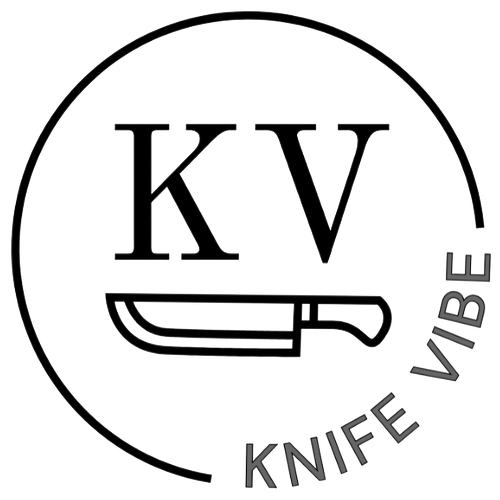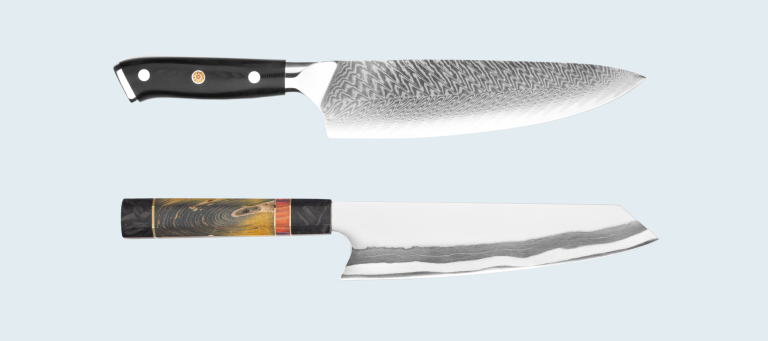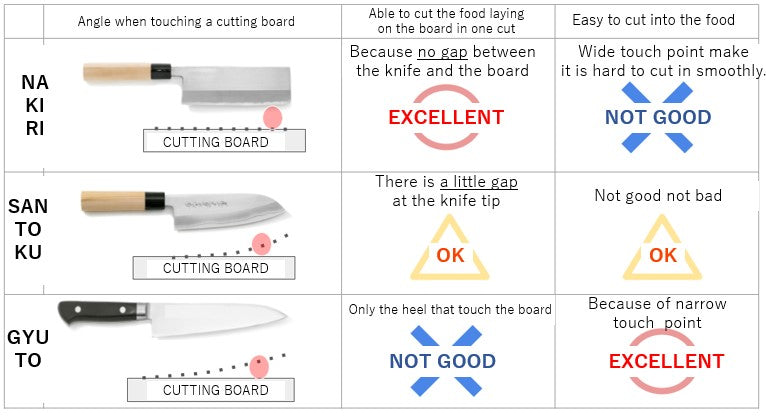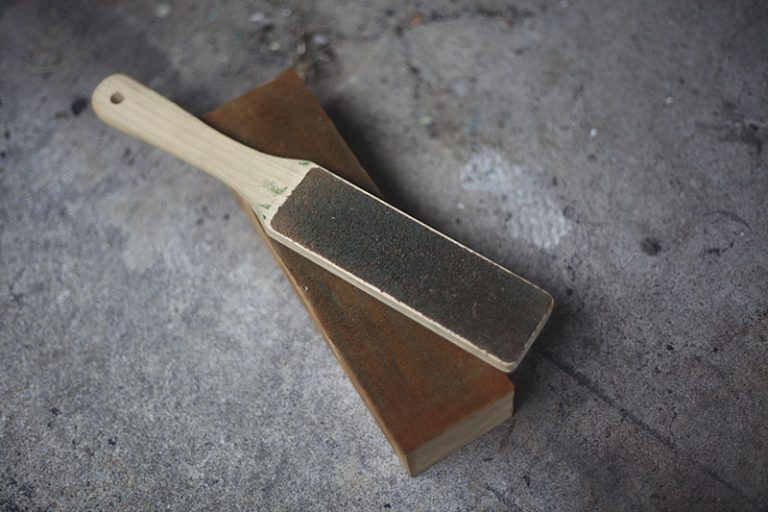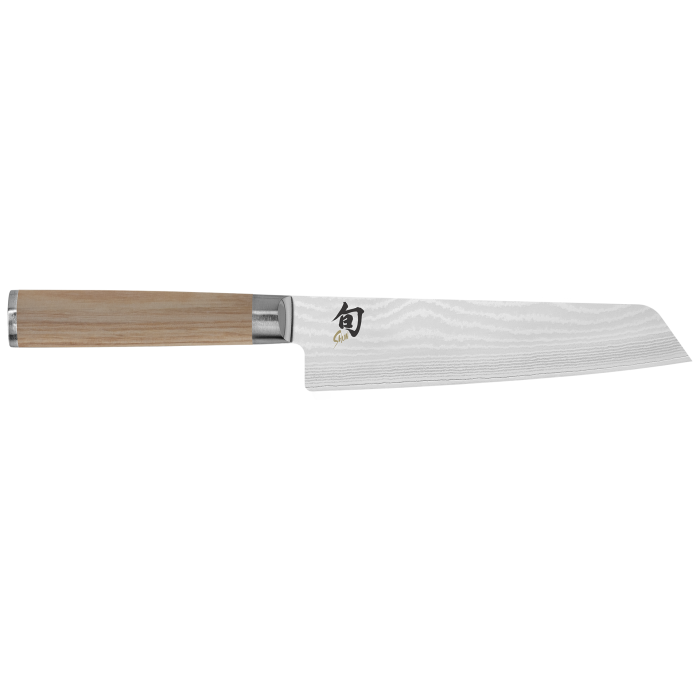Asian Vs Standard Knife: The Ultimate Comparison Guide
Choosing the right knife is essential for cooking. Asian and standard knives each have unique features.
This blog will explore these differences and help you make an informed choice. Asian knives, like the Santoku or Nakiri, often have thinner blades. They excel in precise cuts and vegetable preparation. Standard knives, such as the Chef’s knife, are versatile and robust.
They handle a variety of tasks well, from chopping to slicing. Understanding these distinctions can enhance your cooking experience. By comparing both types, you can determine which knife suits your needs best. Whether you are a home cook or a professional chef, selecting the right knife can make your kitchen tasks easier and more enjoyable. Dive into this comparison to find your ideal kitchen companion.
Introduction To Knife Types
Knives are essential tools in any kitchen. They help with chopping, slicing, and dicing. But not all knives are the same. There are many types of knives. Two common types are Asian knives and standard knives. Each has its unique features and uses. Knowing the differences can help you choose the right knife for your needs.
Defining Asian Knives
Asian knives often have a thinner, sharper blade. These knives are usually made of harder steel. This makes them perfect for precise cuts. Common Asian knives include the Santoku and the Nakiri. The Santoku knife is versatile. It can chop, slice, and dice with ease. The Nakiri knife is ideal for cutting vegetables. Its flat edge ensures clean cuts.
Defining Standard Knives
Standard knives are also known as Western knives. They usually have a thicker, heavier blade. These knives are made of softer steel. This makes them more durable but less sharp. Common standard knives include the chef’s knife and the paring knife. The chef’s knife is versatile. It handles most kitchen tasks well. The paring knife is small. It is great for peeling and detailed work.

Credit: www.thekitchn.com
Blade Materials
Choosing the right knife depends on many factors. One of the most important is the material of the blade. The blade material affects the knife’s sharpness, durability, and maintenance. Let’s explore the common materials used in both Asian and Standard knives.
Common Materials In Asian Knives
Asian knives, such as Japanese and Chinese knives, often use high-quality materials. These materials ensure precision and longevity.
- Carbon Steel: Known for its sharpness and edge retention. Carbon steel can rust if not maintained.
- VG-10 Stainless Steel: A popular choice for its balance of sharpness and rust resistance.
- High-Carbon Stainless Steel: Combines the best of both worlds. It offers sharpness and rust resistance.
- Damascus Steel: Not just beautiful. It’s also durable and holds an edge well.
These materials are chosen for their ability to create thin, sharp edges. They are perfect for intricate cutting tasks.
Common Materials In Standard Knives
Standard knives, often found in Western kitchens, use different materials. These are chosen for robustness and versatility.
- Stainless Steel: Common and affordable. It resists rust but may need frequent sharpening.
- High-Carbon Stainless Steel: More durable and holds an edge better than standard stainless steel.
- Ceramic: Extremely hard and stays sharp for a long time. But it can chip easily.
These materials are ideal for a variety of kitchen tasks. They are often more forgiving and easier to maintain for everyday use.
Understanding the materials used in Asian and Standard knives helps make an informed choice. Each material has its strengths, so choose based on your needs and cooking habits.
Blade Design And Shape
Blade design and shape are crucial factors in the performance of a knife. These aspects determine how the knife handles different tasks. They influence sharpness, precision, and ease of use. Let’s explore the differences between Asian and Standard knife designs.
Asian Knife Designs
Asian knives often have a thinner blade. This design allows for precise, delicate cuts. The most famous is the Santoku knife. It features a straight edge and a sheep’s foot tip. Another popular design is the Nakiri knife. It has a rectangular blade, perfect for chopping vegetables.
Asian knives usually have a single-bevel edge. This means the blade is sharpened on one side only. It results in a sharper edge but requires more skill to use. Many Asian knives are made from harder steel. This helps maintain sharpness longer but can make the blade more brittle.
Standard Knife Designs
Standard knives, often called Western knives, have thicker blades. They are designed for heavier tasks like cutting through bone. The most common type is the Chef’s knife. It has a curved edge, ideal for rocking motions while cutting.
Western knives typically have a double-bevel edge. The blade is sharpened on both sides. This makes them easier to use for most people. They are often made from softer steel. This makes the blade more durable and less likely to chip.

Credit: www.cookwarenmore.com
Edge And Sharpness
The edge and sharpness of a knife play a crucial role in its performance. Many factors affect the sharpness and longevity of a knife’s edge. The design of the edge is one of the main differences between Asian and standard knives. Let’s explore these differences in detail.
Edge Types In Asian Knives
Asian knives, such as the popular Santoku and Nakiri, often have a single-bevel edge. This means only one side of the blade is sharpened. This design allows for very thin and precise cuts. The sharper angle of the edge also ensures a cleaner slice, especially for vegetables and fish.
Another common edge type in Asian knives is the double-bevel edge. Both sides of the blade are sharpened. This type provides a balanced cut and is easier for beginners to use. The double-bevel edge is common in Gyuto knives, which are versatile and similar to Western chef knives.
Edge Types In Standard Knives
Standard, or Western, knives typically have a double-bevel edge. Both sides of the blade are sharpened to create a symmetrical point. This design offers durability and is suitable for a wide range of tasks. Western knives usually have a thicker blade, which provides strength for cutting through tougher materials.
Another edge type found in standard knives is the serrated edge. This design is common in bread knives. The saw-like teeth of a serrated edge make it easy to cut through crusty bread or tomatoes without crushing them. These knives require less frequent sharpening but need special tools for maintenance.
Handle And Grip
Choosing the right knife depends on many factors. One of the most important is the handle and grip. The handle can affect how comfortable and effective the knife is. Let’s dive into the differences between Asian and standard knife handles.
Handle Designs In Asian Knives
Asian knife handles have distinct features. They are often made from wood or composite materials. This makes them lightweight and easy to handle. The handles are usually round or octagonal. This shape allows for a comfortable grip. Many Asian knives have a “wa” handle. This is a traditional Japanese design. It has a tapered end which fits well in the hand.
Here are some common features of Asian knife handles:
- Lightweight materials
- Round or octagonal shape
- Traditional “wa” handle design
Handle Designs In Standard Knives
Standard knife handles often differ. They are usually made from synthetic materials like plastic or rubber. This makes them durable and easy to clean. The handles are typically contoured to fit the hand. This helps in providing a secure grip. Some standard knives have a full tang. This means the blade extends into the handle. It offers better balance and strength.
Here are some common features of standard knife handles:
- Synthetic materials
- Contoured shape
- Full tang design
Below is a comparison table of the handle features:
| Feature | Asian Knives | Standard Knives |
|---|---|---|
| Material | Wood or composite | Plastic or rubber |
| Shape | Round or octagonal | Contoured |
| Design | “Wa” handle | Full tang |
Weight And Balance
Knife weight and balance can impact your cooking experience. Understanding these differences helps you choose the right tool. Let’s explore the weight and balance of Asian and standard knives.
Weight Characteristics Of Asian Knives
Asian knives, like Japanese and Chinese styles, are usually lighter. These knives focus on precision and control. The light weight helps with quick, repetitive cuts. You can slice thinly and finely with ease. Most Asian knives have a thinner blade. This design reduces the overall weight.
Weight Characteristics Of Standard Knives
Standard knives, often from Western countries, tend to be heavier. They provide more heft for cutting through tough materials. The additional weight helps with chopping dense vegetables and meats. These knives often have thicker, sturdier blades. The balance leans towards the handle, giving a solid feel.
Usage And Versatility
Understanding the usage and versatility of Asian and standard knives can help you choose the right tool for your kitchen. Each type of knife has its own strengths and ideal uses. Knowing these can make your cooking experience more efficient and enjoyable.
Best Uses For Asian Knives
Asian knives, like the Santoku and Nakiri, excel at precise cutting. They are perfect for slicing vegetables thinly. These knives have a sharp edge that makes clean cuts. Asian knives are lighter, reducing hand fatigue during long prep sessions. Chefs prefer them for delicate tasks. Their thin blades allow for intricate work, such as mincing herbs.
Best Uses For Standard Knives
Standard knives, like the chef’s knife, are versatile and sturdy. They handle tough tasks like cutting through bone. These knives are great for chopping large vegetables. Their weight helps with forceful cuts. Standard knives are reliable for slicing meats. They offer a balance of strength and precision, making them a staple in many kitchens.

Credit: chefschoice.com
Maintenance And Care
Maintaining and caring for your knives is crucial. It ensures their longevity and performance. Asian knives and standard knives have different maintenance needs. Proper care will keep them sharp and functional. Let’s explore how to care for each type.
Caring For Asian Knives
Asian knives are often made with harder steel. This makes them sharp but more brittle. Hand wash your Asian knife with mild soap and water. Avoid putting it in the dishwasher. Dry it immediately with a soft cloth to prevent rust.
Sharpen your Asian knife with a whetstone. Use a 15-degree angle for sharpening. This maintains the sharp edge. Store it in a knife block or on a magnetic strip. This prevents damage to the blade.
Caring For Standard Knives
Standard knives are usually made of softer steel. They can be more durable but need frequent sharpening. Clean your standard knife by hand washing it. Use warm water and mild soap. Dry it right away to avoid water spots.
Use a sharpening steel or a whetstone for sharpening. Aim for a 20-degree angle. This keeps the edge sharp and effective. Store your standard knife in a knife block or on a magnetic strip. This keeps the blade safe and prolongs its life.
Price And Value
Choosing between Asian and standard knives often boils down to price and value. Both types have their own cost implications. Understanding these can help make an informed decision. Let’s dive into the details.
Cost Of Asian Knives
Asian knives often come with a higher price tag. They are made using traditional methods. These methods involve more labor and craftsmanship. High-quality materials also add to the cost. Many Asian knives feature harder steel. This results in a sharper, longer-lasting edge. The investment can be worth it. A good knife can last for years with proper care.
Cost Of Standard Knives
Standard knives are usually more affordable. They use simpler manufacturing processes. This keeps costs down. The materials used are often less expensive. Stainless steel is a common choice. This makes them easier to maintain. They are a good choice for those on a budget. While they may not last as long, they offer decent value. You can easily replace them when needed.
Choosing The Right Knife
Choosing the right knife for your kitchen can be daunting. There are many options. Two main types are Asian and Standard knives. Each type has its own unique features and benefits. Let’s explore what to consider when making your choice.
Factors To Consider
When deciding between an Asian knife and a Standard knife, consider these factors:
| Factor | Asian Knife | Standard Knife |
|---|---|---|
| Blade Angle | 15 degrees or less | 20 degrees |
| Weight | Light | Heavy |
| Blade Material | Harder steel | Softer steel |
Personal Preferences
Your personal preferences play a big role in choosing the right knife. Think about how you use knives:
- Cooking Style: Do you prepare a lot of vegetables or meats?
- Comfort: Do you prefer a light or heavy knife?
- Maintenance: Are you okay with sharpening often?
Asian knives excel in precision and fine cuts. They are great for slicing vegetables and fish. Standard knives are versatile and robust. They handle tougher tasks like cutting through bones and thick meats.
Frequently Asked Questions
What Is The Difference Between Asian And Standard Knives?
Asian knives are typically lighter with thinner blades, designed for precision. Standard knives are heavier with thicker blades, ideal for tough cutting tasks.
Which Is Better For Precision Cutting?
Asian knives are better for precision cutting due to their lighter weight and thinner blades.
Are Standard Knives More Durable?
Yes, standard knives are generally more durable because of their thicker and heavier construction.
Do Asian Knives Need More Frequent Sharpening?
Yes, Asian knives usually require more frequent sharpening due to their thinner, sharper edges.
Conclusion
Choosing between an Asian and a standard knife depends on your needs. Asian knives are great for precision and fine cuts. Standard knives offer more durability and versatility. Consider the type of food you often prepare. Each knife has its strengths.
Whether you prefer thin slices or heavy-duty chopping, there’s a suitable option. Experiment with both to see what feels right. Your kitchen tasks will guide your choice. Happy cooking!
